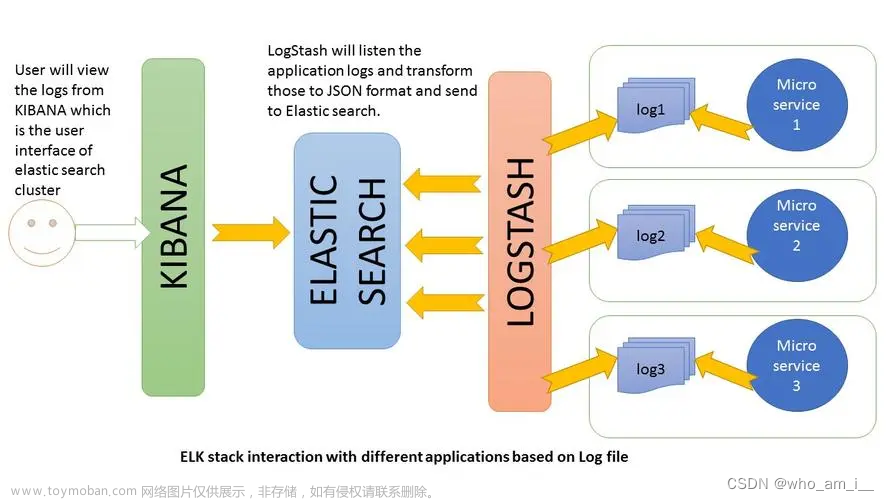写在前面
这篇文章我们来讲讲怎么把logrus日志送到es。
使用的日志库是 github.com/sirupsen/logrus,由于这个包中的日志对象是可以接入很多个hook的,所以我们可以使用hook来接入 elasticsearch 来操作 。
hook 就是钩子,当设置hook在某个点之后,hook会执行这个点之后异步进行。
比如让我们把hook设置到log日志的地方,当我们log日志的时候,就会异步执行hook。
1. logrus对象创建
先定义一个logrus对象
var LogrusObj *logrus.Logger
初始化这个logrus
func InitLog() {
if LogrusObj != nil {
src, _ := setOutputFile() // 设置输出
LogrusObj.Out = src
return
}
logger := logrus.New() // 实例化
src, _ := setOutputFile()
logger.Out = src // 设置输出
logger.SetLevel(logrus.DebugLevel) // 设置日志级别
// 设置日志格式
logger.SetFormatter(&logrus.JSONFormatter{
TimestampFormat: "2006-01-02 15:04:05",
})
LogrusObj = logger
}
上面函数方法中设置的src是日志输出的文件路径,也就是相当于类似下面这种日志文件。
我们用天数来进行日志文件的区分。日志文件如果不存在就创建,存在就进行添加写入日志。
func setOutputFile() (*os.File, error) {
now := time.Now()
logFilePath := ""
if dir, err := os.Getwd(); err == nil {
logFilePath = dir + "/logs/" // 日志文件存储路径
}
_, err := os.Stat(logFilePath)
if os.IsNotExist(err) {
if err := os.MkdirAll(logFilePath, 0777); err != nil {
log.Println(err.Error())
return nil, err
}
}
logFileName := now.Format("2006-01-02") + ".log"
// 日志文件
fileName := path.Join(logFilePath, logFileName)
if _, err := os.Stat(fileName); err != nil {
if _, err := os.Create(fileName); err != nil {
log.Println(err.Error())
return nil, err
}
}
// 写入文件
src, err := os.OpenFile(fileName, os.O_APPEND|os.O_WRONLY, os.ModeAppend)
if err != nil {
log.Println(err)
return nil, err
}
return src, nil
}
至此我们的logrus对象就添加成功了,我们来测试一下。
func TestLogrus(t *testing.T) {
InitLog()
LogrusObj.Infoln("测试日志文件")
}

2. logrus hook
2.1 初始化ES
我们这里用的 es 包是 elastic "github.com/elastic/go-elasticsearch" ,
定义一个es client对象。
var EsClient *elastic.Client
初始化es client对象
// InitEs 初始化es
func InitEs() {
esConn := fmt.Sprintf("http://%s:%s", "localhost", "9200")
cfg := elastic.Config{
Addresses: []string{esConn},
}
client, err := elastic.NewClient(cfg)
if err != nil {
log.Panic(err)
}
EsClient = client
}
2.2 初始化hook
我们这里用的hook是 github.com/CocaineCong/eslogrus 这是我之前封装的一个 logrus 到 es 的小hook。
func EsHookLog() *eslogrus.ElasticHook {
hook, err := eslogrus.NewElasticHook(EsClient, "localhost", logrus.DebugLevel, "index")
if err != nil {
log.Panic(err)
}
return hook
}
调用 eslogrus 包中的 NewElasticHook 方法,传入 es client 对象,es的host,以及日志的输出等级和日志所存储的index。
然后在创建logrus的init函数中,也就是InitLog函数的最后,加入hook即可
hook := es.EsHookLog()
logger.AddHook(hook)
2.3 效果展示
先使用docker启动es,新建docker-compose.yml文件
version: '3.7'
services:
elasticsearch:
image: elasticsearch:8.4.2
container_name: elasticsearch
environment:
bootstrap.memory_lock: "true"
ES_JAVA_OPTS: "-Xms512m -Xmx512m"
discovery.type: single-node
ingest.geoip.downloader.enabled: "false"
TZ: Asia/Shanghai
xpack.security.enabled: "false"
healthcheck:
test: ["CMD-SHELL", "curl -sf http://localhost:9200/_cluster/health || exit 1"] #⼼跳检测,成功之后不再执⾏后⾯的退出
interval: 60s #⼼跳检测间隔周期
timeout: 10s
retries: 3
start_period: 60s #⾸次检测延迟时间
ulimits:
memlock:
soft: -1
hard: -1
volumes:
- /usr/local/elasticsearch/data:/usr/local/elasticsearch/data
- /usr/local/elasticsearch/config/es/config:/usr/local/elasticsearch/config
ports:
- "9200:9200"
restart: always

根目录下执行
docker-compose -f docker-compose.yml up -d
结果
看到这个 status 是 up 的状态即可。
然后我们浏览器访问 http://localhost:9200/ 出现以下信息即可
然后我们再执行一次即可,注意我们的初始化一定要先初始化ES再初始化log。因为log里面用到了es。
这也提到了go中的init函数,在实际开发中,我们不要使用init函数,因为这个init函数是不可控的,不可控意味着这个顺序是不可控的,最好自己手动init。
func TestLogrus(t *testing.T) {
InitEs()
InitLog()
LogrusObj.Infoln("测试日志文件")
}
结果如下
验证一下
curl --location 'http://localhost:9200/index/_search'\?pretty
我们请求一下这个es的查询接口,以及把我们的日志信息放进去了。 index 就是我们的索引,_search就是搜索功能,pretty只是让展示好看一点而已。

下面我们来解析一下eslogrus包中所做的东西,看看我们的log是如何hook到es的!
3. eslogrus
接下来,我们来讲一下eslogrus包是如何 hook 到 es 的
定义一个ES的hook
type ElasticHook struct {
client *elastic.Client // es的客户端
host string // es 的 host
index IndexNameFunc // 获取索引的名字
levels []logrus.Level // 日志的级别 info,error
ctx context.Context // 上下文
ctxCancel context.CancelFunc // 上下文cancel的函数,
fireFunc fireFunc // 需要实现这个
}
定义发送到es的一个消息结构体
// 发送到es的信息结构
type message struct {
Host string
Timestamp string `json:"@timestamp"`
Message string
Data logrus.Fields
Level string
}
新建es hook对象的函数
// NewElasticHook 新建一个es hook对象
func NewElasticHook(client *elastic.Client, host string, level logrus.Level, index string) (*ElasticHook, error) {
return NewElasticHookWithFunc(client, host, level, func() string { return index })
}
func NewElasticHookWithFunc(client *elastic.Client, host string, level logrus.Level, indexFunc IndexNameFunc) (*ElasticHook, error) {
return newHookFuncAndFireFunc(client, host, level, indexFunc, syncFireFunc)
}
新建一个hook
func newHookFuncAndFireFunc(client *elastic.Client, host string, level logrus.Level, indexFunc IndexNameFunc, fireFunc fireFunc) (*ElasticHook, error) {
var levels []logrus.Level
for _, l := range []logrus.Level{
logrus.PanicLevel,
logrus.FatalLevel,
logrus.ErrorLevel,
logrus.WarnLevel,
logrus.InfoLevel,
logrus.DebugLevel,
} {
if l <= level {
levels = append(levels, l)
}
}
ctx, cancel := context.WithCancel(context.TODO())
return &ElasticHook{
client: client,
host: host,
index: indexFunc,
levels: levels,
ctx: ctx,
ctxCancel: cancel,
fireFunc: fireFunc,
}, nil
}
创建消息
// createMessage 创建信息
func createMessage(entry *logrus.Entry, hook *ElasticHook) *message {
level := entry.Level.String()
if e, ok := entry.Data[logrus.ErrorKey]; ok && e != nil {
if err, ok := e.(error); ok {
entry.Data[logrus.ErrorKey] = err.Error()
}
}
return &message{
hook.host,
entry.Time.UTC().Format(time.RFC3339Nano),
entry.Message,
entry.Data,
strings.ToUpper(level),
}
}
异步发送到es
func syncFireFunc(entry *logrus.Entry, hook *ElasticHook) error {
data, err := json.Marshal(createMessage(entry, hook))
req := esapi.IndexRequest{
Index: hook.index(),
Body: bytes.NewReader(data),
Refresh: "true",
}
res, err := req.Do(hook.ctx, hook.client)
if err != nil {
log.Fatalf("Error getting response: %s", err)
}
var r map[string]interface{}
if err := json.NewDecoder(res.Body).Decode(&r); err != nil {
log.Printf("Error parsing the response body: %s", err)
} else {
// Print the response status and indexed document version.
log.Printf("[%s] %s; version=%d", res.Status(), r["result"], int(r["_version"].(float64)))
}
return err
}
这两个是必须要实现的文章来源:https://www.toymoban.com/news/detail-656040.html
// Fire 实现 logrus hook 必须要的接口函数
func (hook *ElasticHook) Fire(entry *logrus.Entry) error {
return hook.fireFunc(entry, hook)
}
// Levels 实现 logrus hook 必须要的接口函数
func (hook *ElasticHook) Levels() []logrus.Level {
return hook.levels
}
以上就是所有 eslogrus 的代码了,短短几十行就能实现 logrus 到 es 的异步了。文章来源地址https://www.toymoban.com/news/detail-656040.html
到了这里,关于【Go语言开发】将logrus日志送到elasticsearch构成elk体系的文章就介绍完了。如果您还想了解更多内容,请在右上角搜索TOY模板网以前的文章或继续浏览下面的相关文章,希望大家以后多多支持TOY模板网!












